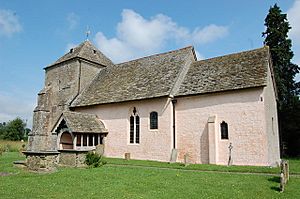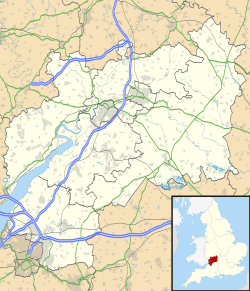St Mary's Church, Kempley facts for kids
Quick facts for kids St Mary's Church, Kempley |
|
|---|---|

The church seen from the southeast
|
|
| 51°58′44″N 2°28′55″W / 51.9788°N 2.4820°W | |
| Location | Kempley, Gloucestershire |
| Country | England, UK |
| Denomination | Church of England |
| History | |
| Status | parish church |
| Dedication | St Mary |
| Architecture | |
| Functional status | redundant |
| Heritage designation | Grade I listed |
| Designated | 2 October 1954 |
| Specifications | |
| Materials | rubble masonry |
| Administration | |
| Deanery | Tewkesbury and Winchcombe |
| Archdeaconry | Archdeaconry of Cheltenham |
| Diocese | Diocese of Gloucester |
| Province | Canterbury |
St Mary's Church in Kempley is a very old church located in the Forest of Dean area of Gloucestershire, England. It is close to the border with Herefordshire. This church is a Grade I listed building, which means it's a very important historical site. St Mary's Church is now owned by English Heritage and cared for by The Friends of Kempley Churches.
Contents
A Church Full of Ancient Art
This simple Norman church was built a long, long time ago. It is now quite far from the main village it once served. What makes it truly amazing are its medieval wall paintings. These paintings are some of the best preserved in all of Britain!
The Amazing Chancel Paintings
The chancel is the part of the church near the altar. It has a rounded ceiling, called a barrel-vault. This entire area, including the ceiling, is covered in paintings. These paintings are very rare and date back to the early 12th century. St Mary's chancel holds "the most complete set of Romanesque frescoes in northern Europe." A fresco is a painting done on wet plaster. One famous painting here is the Christ in Majesty, created around the year 1120.
On the walls of the nave, which is the main part of the church where people sit, there are more paintings. One interesting image shows a "wheel of life," which illustrates the different stages of a person's life. Unlike the frescoes in the chancel, these nave paintings were made using a technique called tempera. This means they were painted on dry lime mortar.
For many years, these beautiful paintings were hidden under a layer of whitewash. They were rediscovered in 1872 when the church was being prepared for repairs. An architect named John Henry Middleton advised against the repairs. Instead, he suggested uncovering and preserving the paintings.
Sadly, attempts to remove the whitewash and other materials caused the paintings to darken. They also started to flake. An English Heritage conservator explained that these efforts, though well-meaning, actually harmed the art. For a long time, experts were trying to decide the best way to restore these areas.
The Oldest Roof in Britain
In 1999, Francis P. Kelly at English Heritage started a special test on the church's oak roof. This test is called dendrochronology, which uses tree rings to find out how old wood is. The Oxford Dendrochronology Laboratory discovered that this roof was the oldest medieval roof ever tested in Britain! It dates back to between 1120 and 1150.
The church has an inside that is unusually well-preserved. The church was repaired and made better in 1913 by Temple Moore. In the early spring, usually from late February to early March, the churchyard becomes a beautiful sight. It is often covered in bright yellow wild daffodils.
St Edward's Church
Kempley is a small village, but it has two important Anglican churches. The other church is St Edward's Church, Kempley. It is also a listed building, but at Grade II*. St Edward's Church was built between 1903 and 1904. It was built by William Lygon, 7th Earl Beauchamp, who owned a lot of land in the area. He built it because St Mary's was too far from where most people lived and sometimes got flooded.
St Edward's was designed by Randall Wells. It became the main parish church in 1975. This happened after St Mary's was no longer used as a regular church.
Gallery








